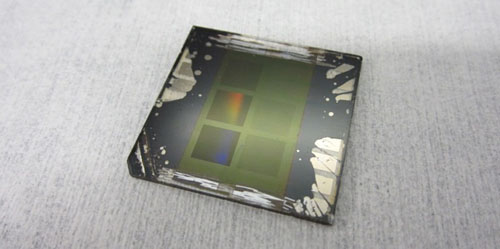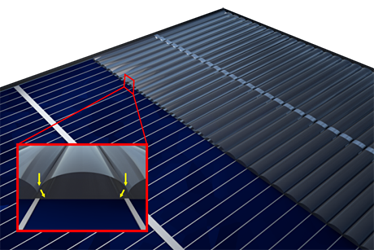Advanced optics and light management
A key strategy for reducing the economic cost of next-generation photovoltaics is to improve their potential to absorb incident solar radiation and convert it into electrical energy. Our group is designing, developing, and prototyping novel optical concepts for improved light injection at the front of the solar module, as well as light absorption concepts that allow all incident light to be directed and absorbed more efficiently in the solar cell. As we detailed in a 2019 perspective paper [1], light management concepts are also key to highly efficient perovskite-based tandem photovoltaics.
Tailored light-matter interaction in nanophotonic perovskite solar cells.
Nanophotonic electrodes and nanostructured perovskite solar cells exploit the full potential of periodic or quasiperiodic 3D nanostructured materials to control spectral and angular light propagation, light injection, and light extraction [2] [3] [ 4]. In a recent study, we reported the simulation-based design, implementation, and prototyping of nanophotonic front electrodes for perovskite/c-Si tandem solar cells, which led to a significant improvement in energy conversion efficiency [5].

Figure 1: Photo of the front surface of prototype perovskite solar cells with nanophotonic front electrodes. The five areas of decreased brightness indicate the areas of nanostructures of the ITO front electrode. The light scattering from the nanostructured electrodes can be seen by a colored haze.
Light deflection around junction lines, contact fingers and dead areas.
Invisibility veiling by free-form surfaces is a new concept for directing incident light away from inactive areas of solar cells for all angles of incidence. In collaboration with our partners, we have realized a free-form surface that allows to make invisible interconnection lines and finger gratings on the front side of solar cells and modules. [6] [7] [8]

Figure 2: Schematic representation of the operating principle of the invisibility cloak, which guides sunlight past the contacts to the active surface of the solar cell. (Graphic: Martin Schumann, APH, KIT).
What does nature teach us for light management in solar cells?
Nature's evolution offers a variety of solutions to scientific and technological challenges. In a 2017 study, we exploited the unique texture of viola petals for improved light output in solar cells [9]. Inspired by these observations, we derived artificial conical microtextures for the front coating of solar modules, which enabled further improved light management [6] [10] [ 11]. In addition to the optical improvements, these microtextures even exhibit a superhydrophobic surface that provides a self-cleaning effect [12].

Figure 3: Viola flower texture improves the external quantum efficiency (EQE) of a silicon solar cell. The reduced reflection of incident light can be clearly seen in the reduced brightness. The Viola texture consists of microscopic cones.

